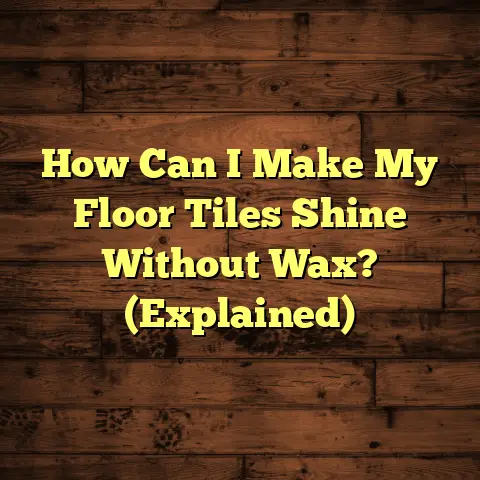Cork-Backed Laminate Need Underlay? (3 Layer Rule!)
Ever walk into a house and just feel the difference? The warmth, the quiet, the overall sense of “ah, I’m home”?
Flooring plays a HUGE part in that, doesn’t it?
I remember installing cork-backed laminate in a client’s sunroom once. Stepping onto it afterward, compared to the cold tile that was there before, was night and day.
It was softer, warmer, and muffled sound noticeably. It brought a sense of coziness that transformed the entire space.
Think of family gatherings, quiet evenings reading a book, or kids playing without echoing through the house. A good floor can make all the difference.
But with so many flooring options, it’s easy to get confused.
Today, we’re diving deep into a hot topic: cork-backed laminate and whether or not it needs underlay.
Let’s get started!
Section 1: Understanding
Cork-Backed Laminate
So, what exactly is cork-backed laminate? And how is it different from the laminate you might already know?
Simply put, it’s laminate flooring that has a layer of cork attached to its underside. Think of it as laminate with built-in padding!
Standard laminate usually consists of:
- A wear layer (the top, protective surface)
- A decorative layer (the printed design)
- A core board (usually high-density fiberboard, or HDF)
Cork-backed laminate adds that fourth layer: a layer of natural cork.
What’s so great about cork, anyway?
Cork is harvested from the bark of cork oak trees, making it a renewable and sustainable resource. Pretty cool, right?
But its benefits go beyond just being eco-friendly:
- Natural Insulation: Cork is a fantastic insulator, keeping your floors warmer in the winter and cooler in the summer.
- Sound Absorption: It acts as a natural sound barrier, reducing noise transmission between floors and rooms.
- Cushioning: Adds a bit of “give” underfoot, making the floor more comfortable to walk on.
- Moisture Resistance: Cork is naturally resistant to moisture, which can help protect your subfloor.
And let’s not forget the aesthetics!
Cork-backed laminate comes in a HUGE variety of styles and colors, mimicking hardwood, tile, and even stone.
Whether you’re going for a rustic farmhouse look or a sleek modern vibe, you can find a cork-backed laminate to match.
Section 2: The Role of Underlay
Okay, so we know what cork-backed laminate is. But what about underlay? What does it do, and why is it even necessary?
Underlay is a layer of material installed between the subfloor (the structural floor beneath) and the finished flooring.
Think of it as a cushion or a buffer that provides several key benefits.
There are many different types of underlay available, each with its own strengths and weaknesses. Here are some of the most common:
- Foam Underlay: Typically made from polyethylene or polyurethane foam. It’s affordable, easy to install, and provides good cushioning and sound absorption.
- Cork Underlay: Made from, you guessed it, cork! Offers excellent sound and thermal insulation, as well as moisture resistance.
- Rubber Underlay: Made from recycled or virgin rubber. It’s durable, provides excellent sound insulation, and is often used in commercial settings.
- Combination Underlay: These combine different materials, such as foam and moisture barrier, to offer multiple benefits.
So, what are the main benefits of using underlay?
- Sound Insulation: Underlay helps to dampen impact noise (like footsteps) and airborne noise (like voices or music). This is especially important in apartments or multi-story homes.
- Thermal Insulation: Underlay can improve the energy efficiency of your home by reducing heat loss through the floor.
- Moisture Protection: Some underlays have a built-in moisture barrier that protects your flooring from moisture damage.
- Cushioning: Underlay adds a layer of cushioning underfoot, making the floor more comfortable to walk on and reducing strain on your joints.
- Subfloor Imperfection Coverage: Underlay can help to smooth out minor imperfections in the subfloor, preventing them from telegraphing through to the finished floor.
- Extending Flooring Life: By reducing wear and tear on the flooring, underlay can help to extend its lifespan.
Section 3: The 3 Layer Rule
Alright, let’s talk about the “3 Layer Rule.”
This is a fundamental concept in flooring installations that helps ensure a successful, long-lasting result.
The 3 Layer Rule simply states that you need to consider three key layers in your flooring project:
- The Subfloor: This is the foundation upon which your entire flooring system rests. It’s typically made of concrete or wood.
- The Underlay (Optional): This is the intermediate layer that provides cushioning, sound insulation, moisture protection, and other benefits.
- The Finished Flooring: This is the visible layer that you walk on, such as laminate, hardwood, tile, or carpet.
Each layer plays a crucial role in the overall performance of your floor:
- The Subfloor: Provides a stable, level, and clean surface for the underlay and finished flooring to be installed on. A properly prepared subfloor is essential for preventing issues like unevenness, squeaking, and premature wear.
- The Underlay: As we discussed earlier, underlay provides a range of benefits that enhance the comfort, durability, and longevity of the flooring.
- The Finished Flooring: Provides the aesthetic appeal, durability, and functionality that you desire.
How does the 3 Layer Rule apply to cork-backed laminate?
Well, because cork-backed laminate already has a layer of cork attached, it seems like you might be able to skip the underlay.
And in some cases, you can! But it’s not always that simple.
We’ll dive into the specifics of when underlay is necessary (or not) in the next section.
For now, just remember that the 3 Layer Rule is a helpful framework for thinking about your flooring project and ensuring that you’re considering all the necessary components.
Section 4: Do Cork-Backed Laminate
Floors Need Underlay?
This is the million-dollar question, isn’t it?
The short answer is: it depends.
I know, I know, that’s not the definitive answer you were hoping for. But let me explain.
Because cork-backed laminate already has a layer of cork attached, it provides some of the benefits that underlay would typically provide:
- Some sound insulation
- Some thermal insulation
- Some cushioning
So, in certain situations, you might be able to get away with installing it directly over the subfloor.
However, there are several factors to consider before making that decision:
- Subfloor Condition: Is your subfloor perfectly level, clean, and free of imperfections? If not, underlay can help to smooth out minor irregularities and prevent them from telegraphing through to the finished floor.
- Moisture Levels: Is your subfloor prone to moisture? If so, you’ll definitely want to use an underlay with a built-in moisture barrier to protect your laminate.
- Noise Requirements: Are you concerned about noise transmission? If you live in an apartment or have kids who like to run and jump, underlay can significantly reduce impact noise.
- Warranty Requirements: Some laminate manufacturers require the use of underlay in order to maintain the warranty. Be sure to check the manufacturer’s specifications before installing your floor.
- Personal Preference: Do you want a softer, more cushioned feel underfoot? If so, underlay can provide that extra level of comfort.
Here’s a breakdown of when underlay is generally recommended:
- Concrete Subfloors: Concrete subfloors are often uneven and prone to moisture. Underlay with a moisture barrier is essential in these situations.
- Basements: Basements are also prone to moisture, so underlay with a moisture barrier is a must.
- Multi-Story Homes: Underlay is highly recommended to reduce noise transmission between floors.
- High-Traffic Areas: Underlay can provide extra cushioning and support in high-traffic areas, reducing wear and tear on the laminate.
Here’s when you might be able to skip the underlay:
- Perfectly Level Wood Subfloor: If your wood subfloor is perfectly level, clean, and dry, and you’re not concerned about noise or moisture, you might be able to install the cork-backed laminate directly on it.
- Manufacturer’s Approval: If the laminate manufacturer specifically states that underlay is not required, and you meet all of their other requirements, you might be able to skip it.
In my experience, it’s almost always better to err on the side of caution and use underlay.
The added cost is usually minimal compared to the potential benefits: improved comfort, better sound insulation, increased moisture protection, and a longer lifespan for your floor.
Section 5: Case Studies and
Real-Life Applications
Okay, let’s get into some real-world examples.
I’ve worked on dozens of flooring projects over the years, and I’ve seen firsthand the difference that underlay can make.
Case Study 1: The Noisy Apartment
I had a client who lived in an apartment building with thin walls and floors. She was constantly getting complaints from her downstairs neighbor about noise.
We installed cork-backed laminate flooring with a high-quality soundproof underlay.
The results were dramatic. The neighbor reported a significant reduction in noise, and my client was finally able to relax and enjoy her home without worrying about disturbing others.
She told me it was the best investment she had ever made!
Case Study 2: The Damp Basement
Another client had a basement that was prone to moisture. He wanted to install laminate flooring, but he was concerned about water damage.
We installed cork-backed laminate with an underlay that had a built-in moisture barrier.
Years later, the floor still looks great, with no signs of water damage or mold.
The underlay provided the necessary protection to keep the floor dry and prevent costly repairs.
Case Study 3: The Perfectly Level Subfloor
I had a client with a perfectly level, dry, and clean wood subfloor.
He was on a tight budget and wanted to save money by skipping the underlay.
I advised him that it was possible, but I also explained the potential risks.
He decided to go ahead without the underlay.
A few months later, he called me back. He said that the floor felt a bit hard underfoot and that he could hear every footstep.
He regretted not using underlay and wished he had listened to my advice.
These case studies illustrate a few key points:
- Underlay can make a HUGE difference in sound insulation, especially in apartments or multi-story homes.
- Underlay with a moisture barrier is essential in basements or other areas prone to moisture.
- Even if your subfloor is in good condition, underlay can still provide added comfort and reduce noise.
Here are a few testimonials from homeowners:
- “I installed cork-backed laminate with underlay in my living room, and it’s so much warmer and quieter than the tile that was there before. I love it!” – Sarah J.
- “I was hesitant to use underlay at first, but I’m so glad I did. It makes the floor feel so much more comfortable and luxurious.” – Michael B.
- “The underlay really helped to smooth out the imperfections in my subfloor. The laminate looks great, and I don’t have to worry about any unevenness.” – Emily K.
Section 6: Installation Tips and
Best Practices
Alright, let’s talk about how to install cork-backed laminate flooring, whether you’re using underlay or not.
Here’s a step-by-step guide:
- Prepare the Subfloor: This is the most important step. Make sure your subfloor is clean, level, and dry. Remove any debris, nails, or staples. If necessary, use a self-leveling compound to smooth out any imperfections.
- Install Underlay (If Using): Roll out the underlay and cut it to size. Tape the seams together with seam tape. If your underlay has a moisture barrier, make sure it’s facing down.
- Install the Laminate: Start in one corner of the room and work your way across. Follow the manufacturer’s instructions for locking the planks together. Use spacers along the walls to maintain an expansion gap.
- Cut the Last Row: You’ll likely need to cut the last row of planks to fit. Use a jigsaw or a laminate cutter to make clean, accurate cuts.
- Install Transition Strips: Install transition strips where the laminate meets other types of flooring, such as tile or carpet.
- Install Baseboards: Install baseboards around the perimeter of the room to cover the expansion gap and give the floor a finished look.
Here are some common pitfalls to avoid:
- Not Preparing the Subfloor Properly: This is the biggest mistake people make. A poorly prepared subfloor can lead to unevenness, squeaking, and premature wear.
- Not Leaving an Expansion Gap: Laminate flooring expands and contracts with changes in temperature and humidity. If you don’t leave an expansion gap, the floor can buckle or warp.
- Using the Wrong Tools: Use the right tools for the job. A jigsaw or a laminate cutter is essential for making clean, accurate cuts.
- Not Following the Manufacturer’s Instructions: Always follow the manufacturer’s instructions for installation. They know their product best.
The role of underlay in mitigating potential issues:
- Smoothing out Subfloor Imperfections: Underlay can help to smooth out minor imperfections in the subfloor, preventing them from telegraphing through to the finished floor.
- Protecting Against Moisture: Underlay with a moisture barrier can protect your laminate from moisture damage, especially in basements or on concrete subfloors.
- Reducing Noise: Underlay can significantly reduce noise transmission, making your home quieter and more peaceful.
Section 7: Maintenance and Longevity
Okay, you’ve installed your beautiful cork-backed laminate floor. Now, how do you keep it looking its best for years to come?
Here are some maintenance tips:
- Sweep or Vacuum Regularly: Sweep or vacuum your floor regularly to remove dirt, dust, and debris.
- Mop with a Damp Mop: Use a damp mop with a laminate floor cleaner to clean your floor. Avoid using excessive water, as this can damage the laminate.
- Wipe Up Spills Immediately: Wipe up spills immediately to prevent staining.
- Use Furniture Pads: Use furniture pads under the legs of your furniture to prevent scratches and dents.
- Avoid Harsh Chemicals: Avoid using harsh chemicals, abrasive cleaners, or wax-based products on your laminate floor.
How the use of underlay can affect the longevity and durability of the flooring:
- Cushioning: Underlay provides extra cushioning, which can reduce wear and tear on the laminate and extend its lifespan.
- Moisture Protection: Underlay with a moisture barrier can protect your laminate from moisture damage, which can cause warping, buckling, and mold.
- Subfloor Protection: Underlay can protect your laminate from imperfections in the subfloor, which can cause unevenness and premature wear.
Tips on cleaning and caring for cork-backed laminate:
- Use a pH-Neutral Cleaner: Use a pH-neutral cleaner specifically designed for laminate floors.
- Avoid Steam Mops: Avoid using steam mops, as the excessive heat and moisture can damage the laminate.
- Protect Against Sunlight: Protect your laminate from direct sunlight, which can cause fading.
- Inspect Regularly: Inspect your floor regularly for any signs of damage, such as scratches, dents, or warping.
By following these maintenance tips and using underlay when appropriate, you can ensure that your cork-backed laminate floor remains in pristine condition for years to come.
Conclusion
So, we’ve reached the end of our journey into the world of cork-backed laminate and underlay.
I hope you’ve found this article helpful and informative.
Choosing the right flooring solution can be a big decision, but it’s one that can have a HUGE impact on the comfort, beauty, and value of your home.
Remember that feeling we talked about at the beginning? That sense of warmth, comfort, and “ah, I’m home”?
Flooring plays a vital role in creating that feeling.
By understanding the relationship between cork-backed laminate and underlay, you can make an informed decision that will lead to a more comfortable, durable, and enjoyable living space.
Whether you choose to use underlay or not, I encourage you to take the time to prepare your subfloor properly, follow the manufacturer’s instructions, and maintain your floor regularly.
With a little bit of care and attention, your cork-backed laminate floor can bring you years of enjoyment.
Now go forth and create the home of your dreams!





